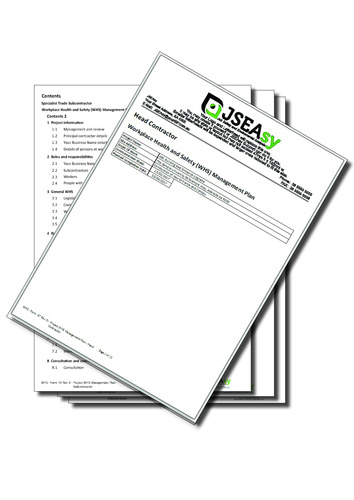WHS Management Plan for a Head Contractor
WHS- Form 47 Project WHS Management Plan Head Contractor – customised and branded for your business.
Ensure full compliance and take control of site safety with this customisable Project WHS Management Plan designed specifically for Head Contractors and Principal Contractors on construction sites.
This Site-Specific WHS Management Plan (SSMP) is a comprehensive, editable document that outlines all key health and safety requirements under Australian WHS legislation. It is essential for managing high-risk construction work, coordinating multiple subcontractors, and demonstrating due diligence on major projects.
The plan includes everything you need—from responsibilities and risk management to emergency response, environmental controls, traffic management, and Safe Work Method Statements (SWMS). Branded with your company’s details, this plan is ideal for tenders, audits, and regulatory compliance.
Key Features:
Developed in line with WHS Act, Regulations, and Codes of Practice
Covers over 15 sections including inductions, incident response, and manual handling
Customisable and company-branded PDF format
Included in the JSEAsy Premium Software package
Supports legal compliance for principal contractors
Whether you’re preparing for a domestic or commercial build, infrastructure project, or government contract, this plan gives you the tools to manage health and safety effectively from day one.
A WHS management plan is a Construction site WHS written plan that sets out the arrangements for managing some site health and safety matters. The intention of a WHS management plan is to ensure the required processes are in place to manage the risks associated with a complex construction project, as there are usually many contractors and subcontractors involved and circumstances can change quickly from day to day.
The WHS management plan must be in writing and must be prepared by the principal contractor before a project commences. It should be easily understood by workers (including contractors and subcontractors). It may not be necessary to communicate the entire WHS management plan to all workers; however, they must be made aware of the parts that are applicable to the work they are carrying out.
Who Should Use This Plan?
Head Contractors
Principal Contractors
Site Managers
Construction Project Supervisors
Any business in charge of managing or coordinating a building site
When is a WHS Management Plan Legally Required?
Under the Model WHS Regulations, which apply in most Australian jurisdictions (e.g. NSW, QLD, SA, ACT, NT, TAS), a WHS Management Plan is mandatory for construction projects valued at $250,000 or more.
Specifically:
Regulation 309(2): The principal contractor must prepare a written WHS management plan for the workplace before work on the construction project commences.
Whether you’re preparing a commercial project, residential development, or infrastructure build, this WHS management plan helps you control risks, meet obligations, and present a professional, compliant front to clients and regulators.
This form is also included in the JSEAsy Software Premium version
Contents
1. Project Information …………………………………………………………………………………………………………………………. 4
1.1. Management and Review ………………………………………………………………………………………………………… 4
1.2. Principal contractor details ………………………………………………………………………………………………………. 4
1.3. Details of persons at workplace with WHS responsibilities …………………………………………………………… 4
2. Roles and responsibilities ……………………………………………………………………………………………………………….. 5
2.1. Principal Contractor ………………………………………………………………………………………………………………… 5
2.2. Subcontractors ………………………………………………………………………………………………………………………. 5
2.3. Workers ………………………………………………………………………………………………………………………………… 6
2.4. People with specific WHS roles and responsibilities ……………………………………………………………………. 6
3. General WHS information ……………………………………………………………………………………………………………….. 6
3.1. Legislation …………………………………………………………………………………………………………………………….. 6
3.2. Codes of Practice and other guidance ………………………………………………………………………………………. 7
3.3. WHS Policy …………………………………………………………………………………………………………………………… 8
3.4. Other Policies ………………………………………………………………………………………………………………………… 8
3.5. Insurances …………………………………………………………………………………………………………………………… 13
4. Risk Management ………………………………………………………………………………………………………………………… 13
4.1. Identifying hazards and risk management ………………………………………………………………………………… 13
4.2. Hierarchy of Control ……………………………………………………………………………………………………………… 14
5. High Risk Construction Work …………………………………………………………………………………………………………. 15
5.1. Safe Work Method Statements (SWMS) ………………………………………………………………………………….. 15
5.2. Licences for High-Risk Work ………………………………………………………………………………………………….. 15
5.3. Asbestos ……………………………………………………………………………………………………………………………… 16
6. Traffic Management ……………………………………………………………………………………………………………………… 16
6.1. Vehicular traffic …………………………………………………………………………………………………………………….. 16
6.2. Pedestrian Traffic …………………………………………………………………………………………………………………. 16
6.2.1. Objectives …………………………………………………………………………………………………………………….. 16
6.2.2. Site Description …………………………………………………………………………………………………………….. 16
6.2.3. Key Risks to Residents …………………………………………………………………………………………………… 16
6.2.4. Control Measures ………………………………………………………………………………………………………….. 17
7. Environmental ……………………………………………………………………………………………………………………………… 17
8. Emergency and incident response ………………………………………………………………………………………………….. 18
8.1. Emergency Preparedness ……………………………………………………………………………………………………… 18
8.2. Emergency Procedure …………………………………………………………………………………………………………… 18
8.3. Emergency meeting point ………………………………………………………………………………………………………. 18
8.4. Emergency Contact list for the site ………………………………………………………………………………………….. 18
8.5. Incident Procedure ……………………………………………………………………………………………………………….. 19
8.6. Notifiable Incidents ……………………………………………………………………………………………………………….. 19
WHS Form 047 Rev 2 Project WHS Management Plan
Head Contractor Page 3 of 33
8.6.1. Fatalities ………………………………………………………………………………………………………………………. 19
8.6.2. Serious injuries or illnesses …………………………………………………………………………………………….. 19
8.6.3. Dangerous Incident ……………………………………………………………………………………………………….. 20
8.7. First Aid ………………………………………………………………………………………………………………………………. 21
8.8. Emergency Contacts …………………………………………………………………………………………………………….. 22
9. Inductions and Training …………………………………………………………………………………………………………………. 23
9.1. Worker Induction ………………………………………………………………………………………………………………….. 23
9.2. Worker Training ……………………………………………………………………………………………………………………. 23
10. Consultation and Communication ………………………………………………………………………………………………. 23
10.1. Consultation ………………………………………………………………………………………………………………………… 23
10.2. Communication ……………………………………………………………………………………………………………………. 24
10.3. Disciplinary Procedures …………………………………………………………………………………………………………. 24
11. Site Safety Procedures ……………………………………………………………………………………………………………… 24
11.1. Site Rules ……………………………………………………………………………………………………………………………. 24
11.2. Site Amenities ……………………………………………………………………………………………………………………… 25
11.3. Site Security ………………………………………………………………………………………………………………………… 25
11.4. Site Signage ………………………………………………………………………………………………………………………… 25
11.5. Personal Protective Equipment (PPE) …………………………………………………………………………………….. 26
11.6. Managing construction hazards specified in the Regulations ……………………………………………………… 26
11.6.1. Falls from Heights ………………………………………………………………………………………………………….. 26
11.6.2. Falling objects ……………………………………………………………………………………………………………….. 27
11.6.3. Demolition Work ……………………………………………………………………………………………………………. 27
11.6.4. Excavation Work/ Trenching ……………………………………………………………………………………………. 27
11.6.5. Work near overhead or underground essential services ……………………………………………………… 27
11.6.6. Electrical ………………………………………………………………………………………………………………………. 28
11.6.7. Plant ……………………………………………………………………………………………………………………………. 29
11.6.8. Scaffolds ………………………………………………………………………………………………………………………. 30
11.7. Managing other Construction Hazards …………………………………………………………………………………….. 30
11.7.1. Ladder Safety ……………………………………………………………………………………………………………….. 30
11.7.2. Manual Handling ……………………………………………………………………………………………………………. 31
11.7.3. Slips, Trips and Falls ……………………………………………………………………………………………………… 31
11.7.4. Using Hand Operated and Power Tools ……………………………………………………………………………. 32
11.7.5. Sun Safety ……………………………………………………………………………………………………………………. 32
12. Safe Work Method Statements (SWMS) ……………………………………………………………………………………… 32
13. Storage movement and disposal of construction materials and waste …………………………………………….. 33
14. Safety in Design ………………………………………………………………………………………………………………………. 33
15. Auditing ………………………………………………………………………………………………………………………………….. 33

